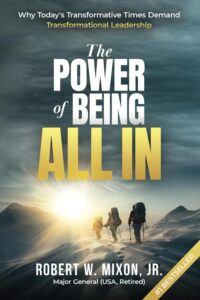This is the latest entry in a series of blogs based off the latest Level Five Associates book, The Power of Being All In.
Webster defines an outlier as “someone who stands apart from others in his or her group.” In many ways, we are all outliers now. The turmoil of the last few years has left many of us feeling more distant from others than ever before.
This is not a totally new phenomenon, however. According to a reading of Cigna’s 2020 Loneliness Index, which measured loneliness and social isolation, three out of five employed adults reported feeling lonely even before the pandemic. Since then, we have become far more distant in living our lives, a nation of outliers.

These days, just get on a plane and see who talks with other passengers. Very few people say anything to the people around them. Just as in the airport waiting area, earbuds and cell phones are the primary tools in the traveler’s toolbox. They help us build a bubble around ourselves, even when we are surrounded by others.
One of the corporate executives I interviewed in The Power of Being All In, Ms. Jeni Bukolt, Founder and Creative Maven of Haven Creative, summarized her approach to the outlier problem this way:
“The most complex leadership challenge I currently face is maintaining a positive company culture while working completely remote. We are continually looking for innovative ways to communicate, celebrate each other, and build comradery to reduce feelings of burnout and isolation.”
It’s abundantly clear we are living in a more isolated world, both personally and professionally. Social media is now considered by many to be a place of refuge where we can interact in relative safety. For some, it’s another dimension, a place where they can interact with others without having to be completely authentic.
These factors exacerbate the outlier tendency, and our human interaction skills suffer accordingly. We don’t practice active communication; rather, we often just exchange information and believe that’s an acceptable alternative. It’s not.
We must take on the task of reducing the sense of social isolation our team members may be feeling.
As adaptive leaders, we must learn to model positivity, curiosity, and confidence. These are the antidotes to the loneliness and isolation many in our organizations feel, brought on by the anxiety of separation.
In essence, we are tribal animals – seeking to belong. That’s who we are, and effective leaders understand this basic need and work toward satisfying that need in everything they do in order to lead by example. In daily audits of our leadership performance, we have to ask ourselves:
- What did I do today to make my team members feel they belong?
- What can I do better tomorrow?
Make this audit a part of your leadership toolbox – and enjoy the journey!
 This blog post is based on the book, “The Power of Being All In.” You can download the first chapter for free at this link. Or, if you’d like to purchase the entire book (available in paperback, eBook, and audiobook), it is available on Amazon.
This blog post is based on the book, “The Power of Being All In.” You can download the first chapter for free at this link. Or, if you’d like to purchase the entire book (available in paperback, eBook, and audiobook), it is available on Amazon.
Did you find this blog post beneficial? If so, please consider sharing it with your audience. It’ll just take a second, but could improve someone’s work habits for a long time to come.





